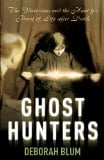The Ghost Hunters
 by Deborah Blum
by Deborah Blum
Arrow Books, £8.99 (pb), ISBN 978-0099469346
In 1848, in Hydesville, New York, two sisters, Kate and Margaret Fox, began ‘communicating’ with the spirit of a murdered man using a series of coded rapping sounds. Whatever their motives initially, these girls were to become the originators of the modern Spiritualist movement. Within a few years, hundreds of mediums and sensitives would discover an ability to communicate with the dead and séances would provide an exciting repertoire of voices, rapping, manifestations and spirit guides, bringing messages from The Other Side.
These séances in turn attracted ‘investigators’, most of whom were either already believers or sceptics eager to expose self-deception or outright fraud. Deborah Blum, a Pulitzer Prize-winning science journalist, gives an interesting overview of the origins of the spiritualist movement, covering a period roughly coinciding with the life of the psychologist and philosopher William James (1842 – 1910). James devoted much time and effort to what soon became known as Psychical Research but after some 25 years could only conclude that while some of the phenomena he had observed were real, he could give no explanation for them. While Blum does make some attempt to place Spiritualism in a wider historical context, much of the writing is anecdotal, with little attempt to dig beneath the surface. Why, for example, should all those spirits have waited until the mid-19th century to get in touch?
Having decided to reveal their existence, why had they largely gone quiet again by the mid-20th? The Fox sisters we know were eventually outed as frauds, as was the absurd Madame Blavatsky, but what happened to Eusapia Palladino and all the others who seemed so convincing at the time? They seem to have disappeared as abruptly as the dead for whom they provided a bridge to the living world. We ourselves are so surrounded by special effects and created images that tales of spirit guides, ectoplasm and ‘crisis manifestations’ seem no more than historical curiosities and this book does nothing to raise them beyond that.

